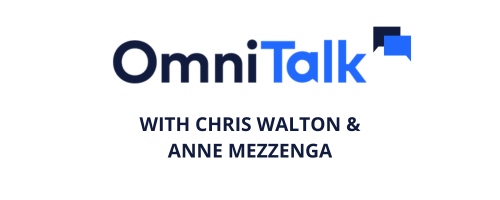Consumer Spending Reality Check & Why Trade-Down Behavior Is Here to Stay with A&M's Chad Lusk | 5IM
In this 5 Insightful Minutes episode, Chad Lusk, Partner and Managing Director at A&M Consumer and Retail Group, joins Omni Talk to break down their latest consumer sentiment survey results that every retailer needs to understand.
From cautious spending increases to the explosive rise of private label brands, Chad reveals why consumers are trading down, what's driving the shift to lower-price stores, and how retailers can navigate the complex landscape of value-conscious shoppers.
You can also read A&MCRG's Consumer Sentiment Survey for Fall 2025 by heading here: alvarezandmarsal-crg.com/insight/cons…y-fall-2025/
🔑 Topics covered:
- Why consumers plan to spend more (but it's not optimism)
- The trade-down trend: cheaper brands and lower-price stores
- How private label is closing the quality gap with national brands
- What holiday spending will look like this year
- Why the middle tier is getting squeezed
🎧 Don't forget to like, comment, and subscribe for more retail insights!
#consumertrends #retailstrategy #privatelabel #consumersentiment #omnitalk #retailinsights #holidayretail #retailpodcast #consumerdata #retaileconomics
*Sponsored Content*
This podcast uses the following third-party services for analysis:
Podcorn - https://podcorn.com/privacy
Transcript
Foreign.
Speaker B:Minutes is longtime friend of the show and a frequent recurring guest and partner and managing director at the A and M Consumer and Retail Group, Chad Lusk.
Speaker B:Chad will be discussing with us the results of A&M CRG's most recent biannual consumer sentiment survey report.
Speaker B:The report draws from a survey of over 2,100 demographically representative U.S. adults and analyzes how shifting economic conditions, among other purchase trends, are shaping consumer behaviors.
Speaker B:Chad, let's start with this.
Speaker B:In the latest report.
Speaker B:I was, I was quite frankly shocked.
Speaker B:Your report says that consumers are indicating an intent to spend more money in the upcoming six month period.
Speaker B:How should we look at this apparent increase in optimism?
Speaker A:Yeah, let's be careful about using that word optimism, okay?
Speaker A:It's cautious at best.
Speaker A:As you said Chris, we did see a bump in consumers intend to spend more this fall to the tune of 800bps.
Speaker A:Actually that's the single largest cycle to cycle jump we've had since spring of 23.
Speaker A:However, however, a few things to note about that.
Speaker A:It's heavily, heavily driven by higher household income earners.
Speaker A:As under $100,000 income households still have a -9 net intent to spend more this period.
Speaker A:In spring of 23 it was similar, but those higher earners had what I'd call recession fatigue.
Speaker A:Right.
Speaker A:A bit of enough is enough and a need to get back to a custom lifestyles despite economic concerns.
Speaker A:Then it snapped right back, actually lower.
Speaker A:So it's a different flavor this time.
Speaker A:Right.
Speaker A:So first of all, across all consumers, food and beverage is actually the only positive category on a net intend to spend more where consumers plan to spend less in every other category with our higher earners there's a few more positive categories, but still a very strong bias to prioritize basic needs.
Speaker A:Back in 23 we saw some discretionary areas pop experiences indulgences this cycle the message is clear.
Speaker A:Keep discretionary spending down.
Speaker A:And further to that, just because consumers expect to spend more doesn't mean they're gonna buy more.
Speaker B:Right?
Speaker A:So even in food and grocery.
Speaker A:Right.
Speaker A:Nearly 60% of consumers believe tariffs have contributed double digit price increases on food.
Speaker A:Actually over 20% say 30 plus percent price increases and over 40% of respondents say that they've decreased grocery purchases because of them.
Speaker A:Right.
Speaker A:So our spend expectations only up because price expectations are up likely as consumers are changing a lot of behaviors and finding ways to counteract inflation to spend less.
Speaker C:So then Chad, if consumers are still trying to stretch their wallets as you're suggesting, how are we expecting that they'll Plan to do that.
Speaker A:Cheaper brands, cheaper stores and buying less.
Speaker A:Right.
Speaker A:So across beauty and personal care, about 40% of those who plan to spend less on the category say they're planning to switch to cheaper brands.
Speaker A:That gets over 50% for grocery skews higher income.
Speaker A:Over 80% of higher income earners told us that they buy private label somewhat or very often.
Speaker A:Then the other big factor is about 30% of those planning to spend less on a category are doing it by switching to lower priced stores across beauty, personal care, grocery, perhaps disrupting their entire ingrained routines at this point.
Speaker A:Yet still get this, 58% of our respondents reported that they've increased trips to lower priced stores somewhat or more often this past cycle alone.
Speaker A:Again that also over indexes in higher income earners.
Speaker A:So maybe it was initially reluctant, you know, maybe they were uncomfortable doing so.
Speaker A:But we have a bunch of data in the report to show how lower priced retailers are performing compared to traditional.
Speaker A:It's actually quite impressive.
Speaker A:May be good enough to change consumers behavior permanently.
Speaker B:So Chad, I'm curious and for the retailers and the CPGs in the audience, what lessons should we take overall from the report?
Speaker A:I think one of the biggest things unfolding right now is the strength of private label for both retailers who can invest behind these programs and CPGs who need to strengthen and defend against them.
Speaker A:Private labels are brands, right.
Speaker A:They no longer stand for generic, they stand for strength.
Speaker A:One of the most interesting charts that we have in the report compares consumer perceptions of store brands.
Speaker A:So private label against national brands in food and beverage.
Speaker A:Yeah, they're more affordable of course, but consumers recognize their quality.
Speaker A:Right.
Speaker A:Like 68% said store brands offer quality that is as good or better.
Speaker A:60% said they provide unique and preferable flavors and offerings.
Speaker A:66% said that they meet their dietary or lifestyle needs.
Speaker A:Those are all the reasons why consumers switch brands.
Speaker A:To save money to experiment and have something unique and because of the ingredient panel.
Speaker A:Right.
Speaker A:So the gap is closed and consumers don't have to make those same kind of sacrifices.
Speaker A:So lesson you know, brands that are doing well offer tremendous value at an opening price point or have tangible benefits that the consumers will spend up to get.
Speaker A:It's that very large middle tier that's that's getting squeezed.
Speaker C:Chad, I have to ask then what, what does this mean for holiday?
Speaker C:We talked a lot about food and beverage but like what, where, where should we net out?
Speaker C:Where should we expect that consumers will net out this holiday season?
Speaker A:Yeah.
Speaker A:Overall our respondents are saying about flat to last year.
Speaker A:The last few years have been up 3 to 4%.
Speaker A:NRF's projecting that as well.
Speaker A:I'd say that's likely to be the case since retail sales are tracking about 4% up on the year, about flat to 1% in real, real growth with the latest PCE report at 3% inflation.
Speaker A:Listen, holiday in a lot of ways falls into these kind of routinely budgeted essentials category at this point.
Speaker A:In a way like I need to buy for my kids, my partner, my family, whomever consumers are telling us they want to spend a of money lot a little less in doing so keep it reasonable, a little down on things like holiday decorations and entertainment.
Speaker A:But as it plays out, the holiday season is a little impulsive too.
Speaker A:Right?
Speaker A:It's like candy at the checkout aisle.
Speaker A:You didn't plan to buy that candy bar, but you're there, it looks good and it's going to make someone happy, in that case, yourself.
Speaker A:That might even be why our respondents are saying they plan to spend a little net more on gifts to their self this year because of that behavior.
Speaker A:But listen, it's November.
Speaker A:Most orders have been made and shipments sent.
Speaker A:So keep on top of your sales signals, manage your inventory promos and markdowns and hopefully we cross that trillion dollar mark for holiday retail sales this year.
Speaker B:Hopefully.
Speaker B:All right, thanks, Chad.



